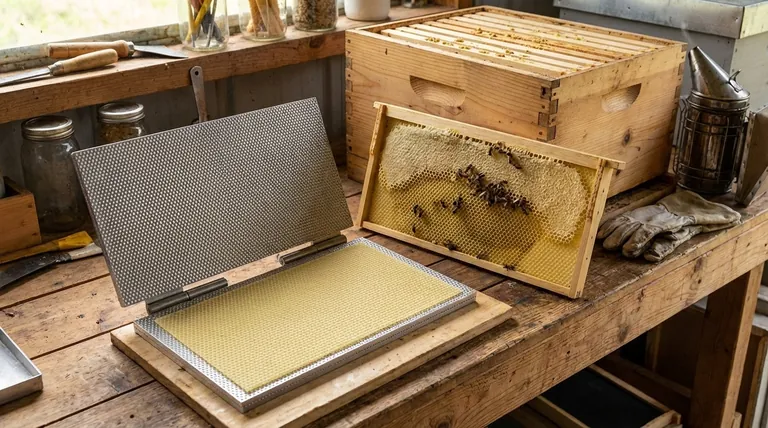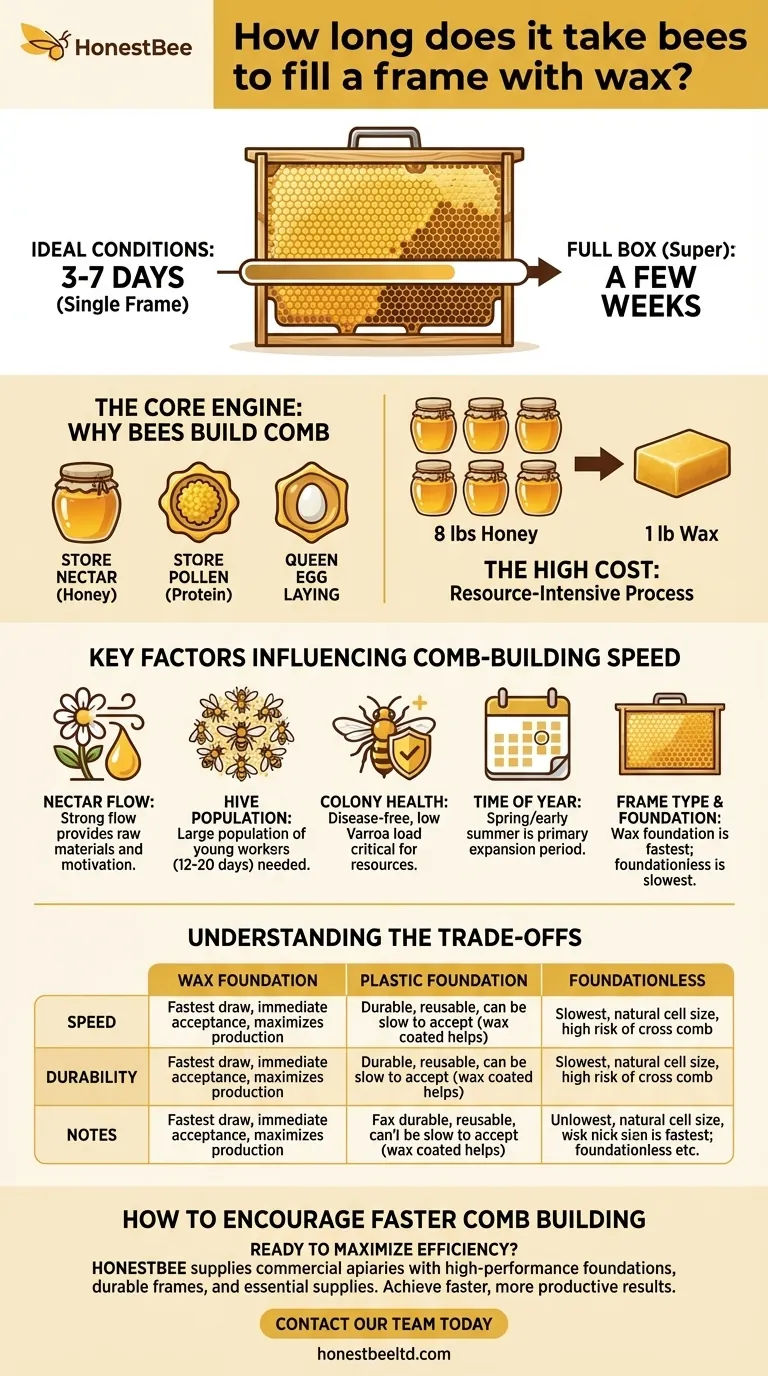Under ideal conditions, a strong, healthy honeybee colony can draw the wax comb and fill a single deep frame in as little as three to seven days. For an entire box of frames (a "super"), this process can take a few weeks. However, this best-case scenario is the exception, not the rule. The actual time is highly dependent on a specific set of factors within and outside the hive.
The speed at which bees build comb is not a fixed timeline but a direct indicator of hive strength, resource availability, and the time of year. Viewing comb construction as a measure of hive health, rather than a deadline, is the correct perspective.

The Core Engine: Why Bees Build Comb
To understand the speed of comb building, you must first understand its purpose and cost. Bees don't build comb just to stay busy; it is a resource-intensive process driven by biological necessity.
The Need for Space
Bees build wax comb for three primary reasons: to store incoming nectar (which becomes honey), to store pollen (their protein source), and to create cells for the queen to lay eggs (to raise new bees). Construction is a direct response to a lack of space for one of these critical functions.
The High Cost of Wax
Producing beeswax is one of the most energy-demanding tasks for a honeybee. It is estimated that bees must consume roughly eight pounds of honey to produce just one pound of wax. Because of this high cost, bees will not produce wax unless all the necessary conditions are met.
Key Factors Influencing Comb-Building Speed
The phrase "it depends" is frustrating but accurate. The speed of construction hinges entirely on the following variables, and a weakness in any one of them can bring the process to a halt.
The Nectar Flow
This is the single most important factor. A strong nectar flow means that local plants are producing abundant nectar, giving bees the raw carbohydrates needed to produce wax and the motivation (storage) to build comb. Without a flow, even a strong colony will not build.
Hive Population
Wax production is primarily done by young worker bees (typically 12 to 20 days old). A hive bursting with a large population of young, healthy bees has the workforce required for rapid construction. A small or dwindling colony simply lacks the manpower.
Colony Health and Age
A newly installed package of bees or a small nucleus hive must prioritize raising brood and establishing a core population. Their initial comb building will be slow. An established, healthy colony that has survived a winter is primed for explosive growth and will draw comb much faster. Diseases, especially a high Varroa mite load, will severely divert resources and cripple a hive's ability to build.
Time of Year
Bees operate on a seasonal calendar. The primary comb-building period is spring and early summer, when nectar is plentiful and the colony's instinct is to expand. As summer wanes and fall approaches, their focus shifts from expansion to storing resources in existing comb for winter, and wax production slows dramatically.
Frame Type and Foundation
The type of frame you provide has a direct impact. Bees will draw out comb on a foundation—a starter sheet of plastic or beeswax imprinted with a honeycomb pattern—much faster than they will on a foundationless frame. The foundation provides a guide and saves them a significant amount of wax and energy.
Understanding the Trade-offs
Your choice of equipment directly influences the speed and character of the comb your bees build. There is no single "best" option; each involves a trade-off.
The Speed of Wax Foundation
Giving bees a sheet of pure beeswax foundation is the fastest way to get perfectly drawn comb. They readily accept the wax and can immediately begin drawing out the cells. This is the preferred method for maximizing honey production or quickly expanding a brood nest.
The Durability of Plastic Foundation
Plastic foundation offers durability and can be scraped and reused for years. While effective, some colonies can be slower to accept and draw out plastic compared to pure wax. A thin coating of beeswax on the plastic can significantly increase its acceptance rate.
The Slower Pace of Foundationless
Foundationless beekeeping allows bees to build comb with their own natural cell sizes, which is a goal for many natural beekeepers. However, this is the slowest method by a wide margin. It requires the bees to build the entire structure from scratch and carries a higher risk of "cross comb" (where bees build comb across multiple frames), which requires beekeeper intervention.
How to Encourage Faster Comb Building
You can't force bees to build, but you can create the ideal conditions to encourage them.
- If your primary focus is rapid expansion and honey production: Use frames with beeswax foundation and feed your bees a 1:1 sugar syrup to simulate a strong nectar flow, especially when establishing a new hive.
- If your primary focus is establishing a strong first-year colony: Ensure the hive is healthy and has a large, growing population before adding new boxes (supers), and feed them consistently until they have drawn out all the frames in their primary brood box.
- If your primary focus is natural beekeeping: Use foundationless frames but accept a much slower build-out, monitor for cross comb, and understand that a first-year honey harvest is less likely.
Ultimately, patience is the beekeeper's greatest tool; a healthy, booming hive will build comb when the time is right.
Summary Table:
| Factor | Impact on Speed | Ideal Conditions |
|---|---|---|
| Nectar Flow | High | Strong, abundant nectar sources available |
| Hive Population | High | Large number of young worker bees (12-20 days old) |
| Colony Health | Critical | Disease-free, low Varroa mite load |
| Time of Year | Seasonal | Spring/early summer for rapid expansion |
| Frame Foundation | Variable | Beeswax foundation for fastest draw-out |
Ready to maximize your hive's efficiency and accelerate comb production? HONESTBEE supplies commercial apiaries and beekeeping equipment distributors with high-performance foundations, durable frames, and essential beekeeping supplies through our wholesale-focused operations. Whether you're scaling honey production or establishing a robust new colony, our expert-selected equipment is designed to support rapid, healthy comb building. Contact our team today to discuss your apiary's needs and discover how we can help you achieve faster, more productive results.
Visual Guide

Related Products
- Notebook Style Beeswax Foundation Mould Wax Foundation Mold
- Food Grade Plastic bee Foundation for Bee Frames
- Electric Flatting and Embossing Machine with Tray for Beekeeping
- Durable Galvanized Steel Frame Grip
- Electric Beeswax Flat Sheet Machine with Operating Tray for Wax Processing
People Also Ask
- How is beeswax foundation secured in wooden frames? Ensure Strong Comb for Healthy Hives
- What is beeswax foundation made of? A Guide to Stronger, More Efficient Hives
- What are the uses of recycled beeswax cappings? Transform Honey Byproducts into Valuable Assets
- How do bees build their honeycomb? A Marvel of Collective Engineering and Efficiency
- What is required when using wax foundation in beekeeping frames? Essential Support for Strong Combs



















